When you’re talking to spacecraft billions of miles away, you need a powerful voice. And when you’re listening for their faint replies from those same staggering distances, you need an even bigger set of ears. Fortunately, NASA’s Deep Space Network has both — and last week I had the chance to see some of them up close and in person as one of the lucky participants in a NASA Social! Here’s my overview of what happened on those two exciting days.
(And if this doesn’t make you want to apply for the next Social, I don’t know what will.)
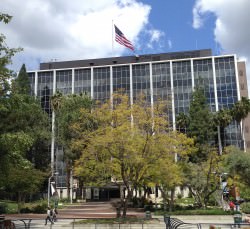
The event began on April 1 (no foolin’) at NASA’s Jet Propulsion Laboratory in Pasadena. Nestled at the feet of steep pine-covered hills northeast of Los Angeles, JPL’s campus is absolutely gorgeous… not quite the location you might imagine for the birthplace of robotic interplanetary explorers! But for over 55 years JPL has been developing some of the world’s most advanced spacecraft, from the Ranger probes which took NASA’s first close-up images of the Moon to the twin Voyagers that toured the Solar System’s outer planets, countless Earth-observing satellites that have revolutionized our ability to monitor global weather, and all of the rovers that have been our first “wheels on the ground” on Mars.
Of course, none of those missions would have been possible if we didn’t have the ability to communicate with the spacecraft. That’s why NASA’s Deep Space Network is such an integral — even if not oft-publicized — part of each and every mission… and has been for 50 years.
In fact, that was the purpose of this Social event which gathered together 50 space fans from across the U.S. — to celebrate the achievements of the DSN with an eye-opening tour of both JPL and the DSN’s Goldstone facility with its flagship 70-meter dish, located amongst the rocky scrub-covered hills in the middle of a military base in California’s Mojave desert.
For many participants — including myself — it was the first time visiting JPL. I can’t tell you how many times I’ve written about the news that comes out of it, featured its amazing images, and typed the credit line “NASA/JPL-Caltech” in the caption of a picture, so for me it was incredible to actually be there in person. Just driving through the front gate at JPL, with “Welcome To Our Universe” mounted over the window of the guard station, was mind-blowing!
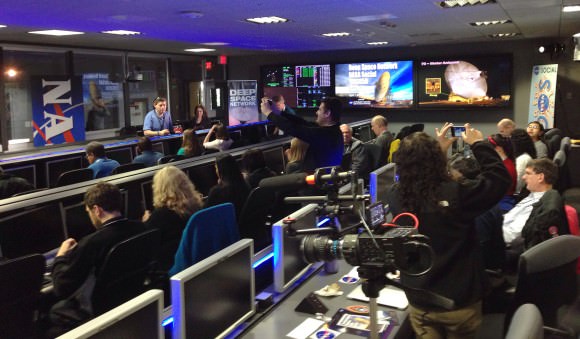
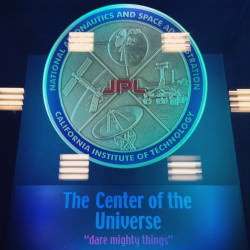
From the Visitor’s Center we were gathered into groups and taken into the heart of JPL to get a look at the Mission Control room, aka the “center of the universe.” This is where all the data from ongoing space exploration missions arrives (after being collected by the Deep Space Network, of course.) And we didn’t just get to see Mission Control — we actually set up our computers there and got to take our seats at the very same desks that top JPL and NASA engineers and scientists used during the MSL landing in August 2012! In fact we were treated to a replay of Curiosity’s landing on the screens against the wall that first displayed the rover’s images of Gale Crater. The whole experience was a bit surreal — I vividly recall watching it live, and there we were in the same room as if it were happening all over again! (We even got to re-enact the celebration of the touchdown announcement as our group photo.)
After several presentations and Q&A sessions with NASA mission engineers — recorded live for NASA TV — we all embarked on a tour of JPL’s rock-strewn “Mars Yard” where a stunt double of Curiosity, named “Maggie,” resides in a super high-tech garage. Maggie helps engineers determine what Curiosity can and can’t do on Mars… much more safely than actually having the “real” rover attempt itself.
Watch the NASA TV coverage from Mission Control below:
The group then got the chance to see an actual spacecraft being built in the Spacecraft Assembly Facility, a huge clean room where engineers were building components of the upcoming SMAP (Soil Moisture Active Passive) satellite. Slated for launch in October, SMAP will take measurements of the planet’s soil moisture in its freeze/thaw states from orbit over a period of three years. As we watched from the windowed viewing platform several “bunny-suited” engineers were busy working on SMAP’s 6-meter reflector. In another six months or so the parts that were scattered around that clean room will be performing science in orbit!
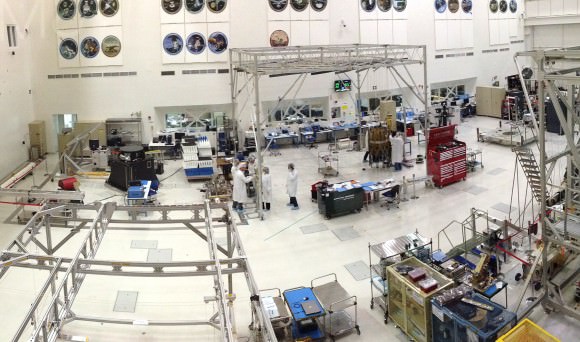
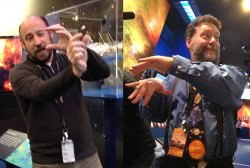
From there it was off to the JPL museum and some intimate (and highly animated!) discussions about mission technology with project formulator Randii Wessen and propulsion engineer Todd Barber. Afterward I took the opportunity to talk with Todd a bit about his role on the Cassini mission, for which he’s the lead propulsion engineer.
(You all know how much I adore Cassini, so that was a real treat.)
When we got back to Mission Control we had a chance to meet with and have photos taken with JPL’s very own “Mohawk guy” Bobak Ferdowsi, who achieved widespread fame during the internet broadcast landing of Curiosity. I had Bobak sign my toy Curiosity rover, which now has a “BF” on the back of its die-cast RTG. One for the space shelf!
The second half of the Social began early the next day — for me, very early. After getting up at 3:15 a.m. and making a two-hour drive from Pasadena to Barstow in the dark, I and the other participants met up with the Social bus in a park-and-ride lot at 6:00 just as the Sun was beginning to brighten the eastern sky. (Some had stayed overnight in Barstow, while others made the early drive out like I did.) Once the bus filled, we headed north into the Mojave to arrive at NASA’s Deep Space Network Communications Complex at Goldstone, located within the Fort Irwin military training area.
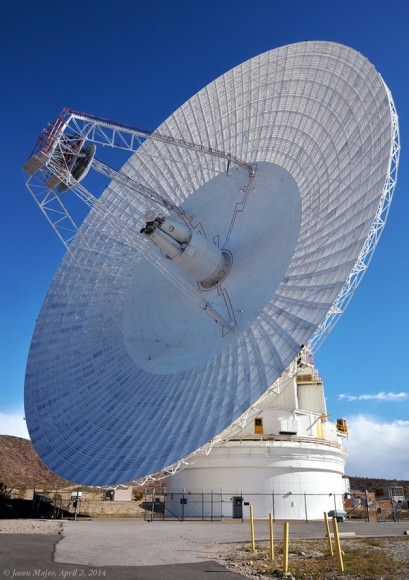
The location is rugged and remote — the perfect place to listen for the faint signals from spacecraft trundling across dusty Mars and soaring through the farthest reaches of the Solar System! The nine main DSN antennas at Goldstone are scattered across several square miles of desert, enormous dishes pointed more-or-less directly upward, aiming at the locations of distant spacecraft in order to both receive and transmit data. All of them are huge, but by far the most impressive is the gigantic 70-meter DSS-14 dish that towers above the rest in both height and width.
Recently renovated , the fully-positionable DSS-14 “Mars antenna” dish (so called because of its first mission tracking the Mariner 4 spacecraft in 1965) weighs in at 2.7 million kilograms yet “floats” atop a thin film of oil a quarter of a millimeter thick!
How smoothly does a three-thousand-ton radar dish move? We got to find out — check out the video below:
(Note: as it turned out, DSS-14 wasn’t turning to communicate with anything… the show was just for us!)
Of course, we all spent plenty of time taking pictures of the 70-meter, both inside and out — we were treated to a tour of this and several other dish sites hosted by JPL’s Jeff Osman, a specialist in the DSN antennas and their operations.
(One of us even chose to record the DSS-14 antenna with pencils and paper — watch fellow Social participant Jedediah Dore’s sketch and account of the experience here.)

Also, watch the local ABC affiliate’snews video of the Social event here.
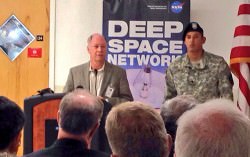
The highlight of the day at Goldstone was (if not just being there!) was being present for the official celebration of the facility’s 50th anniversary. Featuring speakers from JPL and DSN, as well as many esteemed guests, the event — held indoors because of strong winds outside — commemorated the impact and important contributions of the complex over the past half-century of space exploration. According to speaker Jim Erickson of JPL, “There hasn’t been a time in my career when the DSN wasn’t there for us.”
After that the NASA Social group was invited to take a few moments to mingle with speakers and guests — when else would I have a chance to chat with JPL director Dr. Charles Elachi? — and then we all returned to our own meeting room where refreshments were waiting and a (quite delicious) DSN50 cake was cut and served.
It was truly a fantastic and well-planned event, giving 50 people the chance to see an integral part of our space program that, although it doesn’t usually receive the same kind of exposure that rocket launches and planetary landings enjoy, makes all of it possible.
Here’s to 50 more years of DSN and its long-distance relationship with all of our intrepid space explorers!
__________________
See what communications are currently coming in and going out of the DSN dishes — in Goldstone as well as in Madrid and Canberra — here, and learn more about the history of Goldstone here.
Want to see more photos from JPL and Goldstone? Check out my Flickr set here and see photos from all of the participants on the Facebook group page here.
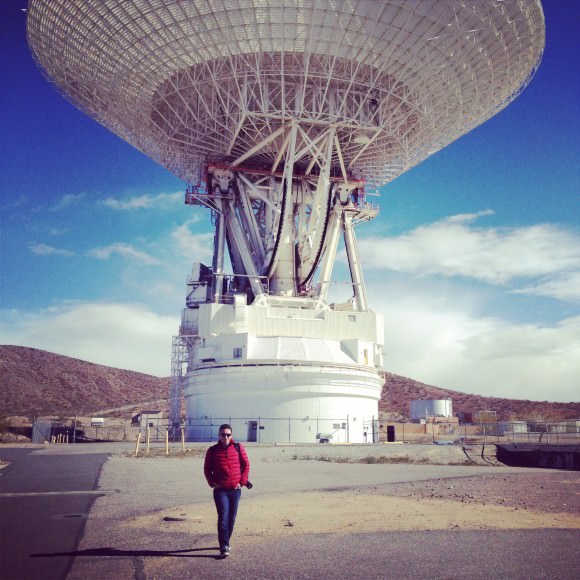
And a big thanks to Courtney O’Connor, Veronica McGregor, John Yembrick, and Stephanie Smith for putting this NASA Social together, Annie Wynn and Shannon Moore for setting up and organizing participant groups on Facebook and Google (which makes offsite planning so much easier), Jeff Osman and Shannon McConnell for the tours of the DSN sites and, of course, everyone at JPL and Goldstone who helped to make the event a wonderful success!
Would you like to be a part of a NASA Social? Find out what events are coming up and how to apply for them here.

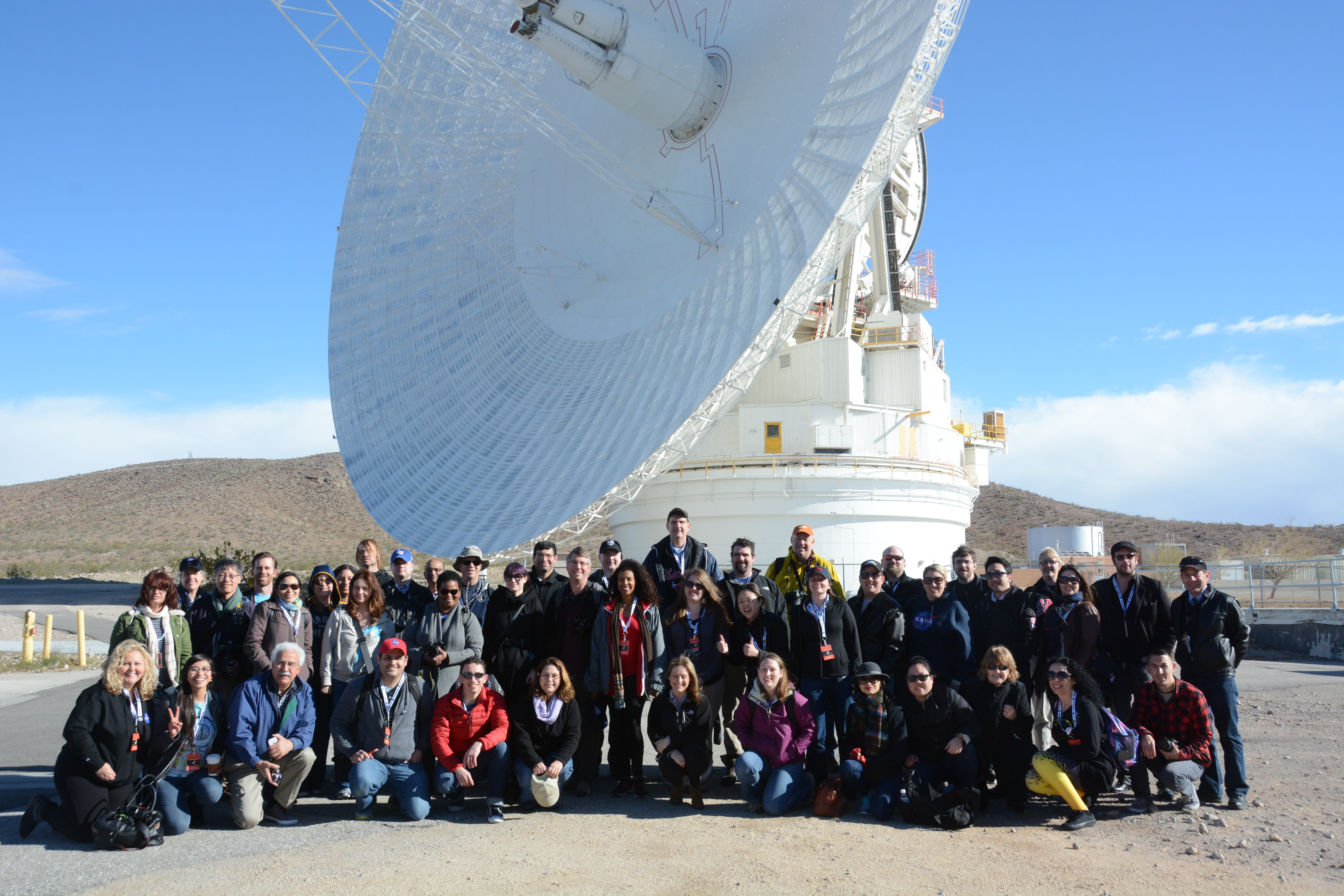
What a treat! Amazing technology to say the least and a testiment to man’s intrepid thirst for exploring our galactic neighborhood and beyond.